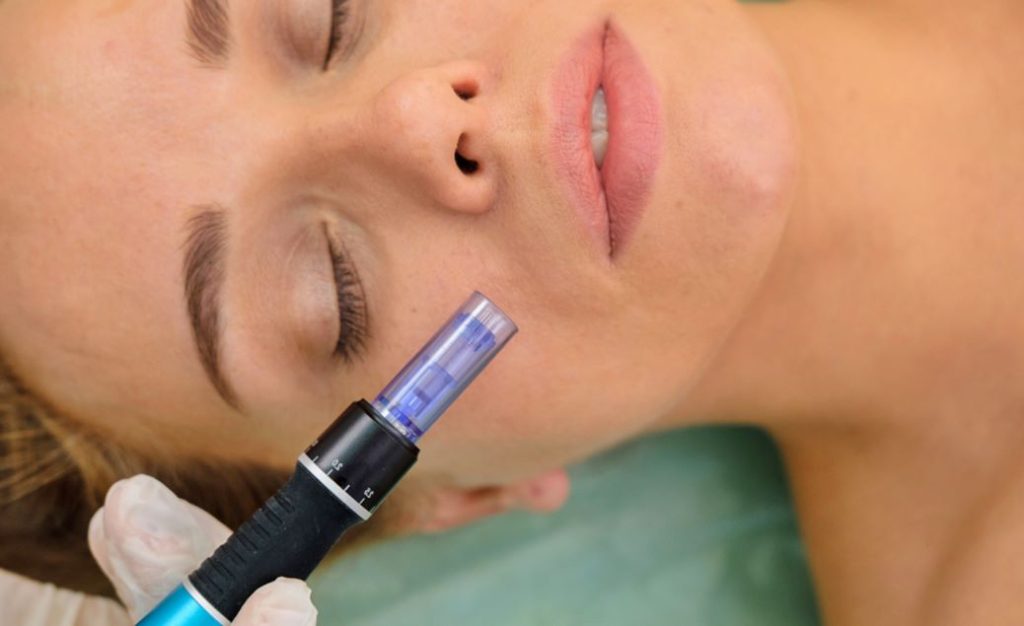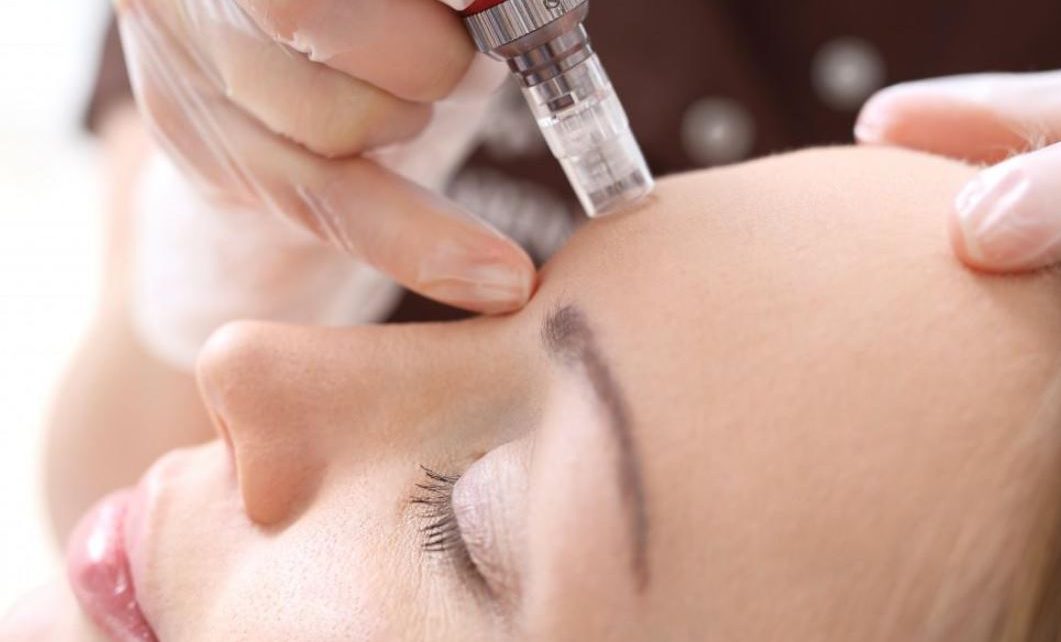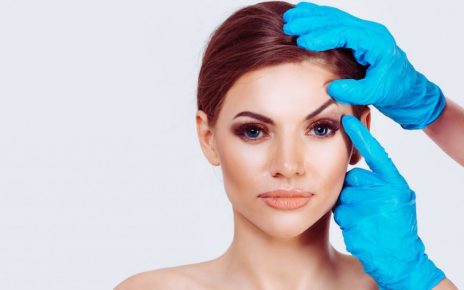Table of Contents
What is microneedling with PRF?
Microneedling with PRF is a minimally invasive procedure for facial rejuvenation. It involves applying the patient’s platelet-rich fibrin (PRF) to the skin and puncturing the skin with fine needles. The needling creates tiny injuries that stimulate skin renewal while the PRF speeds up recovery.
Platelet-rich fibrin is derived from the patient’s blood. It’s a mix of platelets, white blood cells, growth factors, and a clotting protein called fibrin. PRF helps stimulate wound healing and promotes collagen and elastin production.
PRF is a newer version of platelet-rich plasma (PRP) and is sometimes called a second-generation product. The medical use for these products is similar, but where PRP needs anti-clotting additives to activate growth factors, PRF does not. These additives in PRP block natural clotting and slow down the healing process, so experts consider PRF a better product. Without additives, PRF can release healing proteins over a longer time, which gives longer-lasting results.
Essentially, PRF primes the skin with the growth factors and cells it needs to heal. These cells are part of the natural healing cascade, so combining PRF with skin needling feeds the skin and the body its own natural healing ingredients, which speed up recovery time.
How does microneedling with PRF work?
Microneedling treatments use a handheld needling device that creates controlled, superficial injuries that don’t damage the outer layer of a patient’s skin. The process sets off a wound-healing cascade, causing the body to release growth factors and immune cells that generate new tissue.
Cells migrate to these areas and start producing collagen fibers — a protein matrix forms and collagen deposits in the skin, leading to skin tightening. The needles don’t cause real wounds but instead trick the body into sensing an injury and setting off this cascade. Microneedles also break down tissue strands in scars and restore blood flow to the area.
Along with needling, a provider applies PRF to the patient’s skin. The PRF comes from the patient, so the provider must first draw the patient’s blood and then spin it through a centrifuge at a low speed. The machine separates the blood from the plasma, settling the heavier cells to the bottom and increasing the number of platelets and cells available.
Essentially, PRF primes the skin with the growth factors and cells it needs to heal. These cells are part of the natural healing cascade, so combining PRF with skin needling feeds the skin and the body its own natural healing ingredients, which speed up recovery time.
Compared to PRP, PRF doesn’t have any additives that block the healing process, so it steadily releases these growth factors into the skin. The effect is faster and natural healing, more significant collagen and elastin production, and longer-lasting results.
Microneedling is an intentional and controlled skin injury that triggers the body to rejuvenate and repair the skin. PRF can be applied to these micro-injuries to stimulate natural skin tissue renewal further and lead to smoother and firmer skin.
What tools and equipment are needed?
Microneedling with PRF involves two separate treatments in the same appointment, so there are a few necessary tools. Since PRF is a blood product, creating a clean and safe working space is essential. Some equipment and supplies are standard across clinical settings, but others are only for microneedling and PRF.
Personal protective equipment (PPE)
PPE is, of course, a standard tool for an aesthetics practice. However, it’s always important to remember these supplies and consider them in the overhead cost of performing these procedures.
The required PPE includes:
- Hand sanitizer
- Gloves
- Face mask
- Eye protection
- Clean lab area
The practice should have a clean lab area for processing blood products. If there is available space, it’s beneficial to set up a designated processing area in each treatment room.
Some providers offer microneedling with PRF as a concierge service, in which case disposable sterile field supplies will be necessary. Both in-practice and concierge services should have a process or an area for disinfecting and sanitizing devices and machines between patients.
PRF supplies
The PRF step begins with blood collection. The provider cleanses the draw site, usually the arm, collects the blood, and then sets it to spin in the centrifuge. Once the spinning is complete, the PRF is applied to prepped skin.
A provider will need blood draw and PRF supplies, including:
- Alcohol sterilization pads
- Butterfly needle
- Vacutainer®
- Plastic PRF tubes without additives
- Tourniquet
- Gauze and bandaids
- Syringe
- Centrifuge
Some lab supply companies sell FDA-approved PRF collection kits with all the supplies, which is a simpler way to purchase tools and supplies. The centrifuge will be the most significant investment.
Microneedling supplies
The microneedling process has several steps, including facial cleansing, numbing, and needling. Supplies and tools include:
- Antiseptic cleansing soap
- Lidocaine numbing cream
- Alcohol cleansing pads
- Professional-grade microneedling pen
- Sterile needles in different depths or gauges
- Hyaluronic acid or other hydrating serum for slip
- Moisturizing cream
How long is the typical treatment?
A typical microneedling with PRF treatment takes about an hour from start to finish. Here’s a breakdown of what a patient can expect:
- Numbing (20 minutes) – The provider will first cleanse and numb the treatment area, usually the face, with a topical anesthetic cream. This numbing process takes around 20 minutes to fully take effect before the microneedling can begin.
- Microneedling (30 minutes) – Once the area is numb, the provider will use the microneedling device to create controlled microinjuries across the skin. This microneedling process takes the longest, around 30 minutes for a full facial treatment.
- Applying PRF – During the microneedling, the provider will also apply the PRF to the skin to help stimulate healing. This doesn’t add much time to the appointment.
- Total Time: ~60 minutes – With proper numbing, most full-face microneedling with PRF treatments take about an hour from start to finish.
Some factors that can affect the appointment length:
- Smaller treatment areas like just around the eyes or mouth will take less time.
- The technique the provider uses to apply PRF and microneedle may add or reduce time.
- Scheduling more time between appointments allows for better preparation and clean up.
So patients can expect an appointment to last around 60 minutes to allow for adequate numbing, needling, and application of PRF across the full face.
How should patients prepare for microneedling with PRF?
Providers should give patients pre-procedure instructions for the best results, efficient appointments, and an excellent overall experience. Patients should:
- Avoid alcohol for 72 hours before the procedure. Alcohol can thin the blood and increase bleeding and bruising risks.
- Avoid retinol products, hydroquinone, or acids one week before the procedure. These can make the skin more sensitive and prone to irritation.
- Avoid medications, vitamins, herbs, and supplements that have blood-thinning effects for one week prior. These include omegas, NSAIDs like ibuprofen, vitamin E, Ginkgo Biloba, garlic supplements, etc.
- Patients who take prescription blood thinners should not stop taking their medications without first consulting their prescribing doctor. Blood thinners are often prescribed for serious health conditions, so patients should get medical guidance before stopping them for a procedure.
- Come to the appointment with clean skin free of makeup and creams. The provider needs to thoroughly cleanse and prep the skin before treatment.
This preparation can enhance skin health, improve the treatment effects, and lead to better results.
What is the recommended post-treatment care?
After a microneedling with PRF treatment, the skin will flush red and swell slightly. Then it will become quite dry and may slough off over the first few days. During this time, the skin is vulnerable to germs and sensitive to products and the sun. Post-treatment instructions should focus on gently cleansing, hydrating, and protecting the skin.
For the first 24 hours, patients should:
- Avoid all skincare products
- Avoid exercise up to 48 hours post-treatment
- Avoid all makeup
- Take only acetaminophen for pain or discomfort
- Keep hair off the face
For the first week, patients should avoid:
- Anti-inflammatory medications, like ibuprofen and naproxen
- Antihistamines, like over-the-counter allergy medications
- Steroid medications
- Blood-thinning herbs, vitamins, and supplements
- Rubbing or scrubbing the skin
Patients can start cleansing and maintaining the skin after 24 hours. Providers often recommend:
- Washing hands before touching the skin
- Using a gentle cleanser with lukewarm water and gently patting the skin dry
- Any treatment enhancing creams, if desired, like Alastin® Regenerating Skin Nectar
- Hyaluronic acid and a light moisturizer to help with dryness
- Applying makeup with clean or new brushes
- Daily sunscreen of at least 30 SPF
Who can perform this treatment?
Only licensed medical professionals can perform microneedling with PRF. The procedure involves puncturing the skin and drawing and working with blood products, so providers must have the training and the legal ability to perform these tasks. Microneedling with PRF is within the scope of practice for medical doctors, registered nurses, nurse practitioners, and physician assistants.
But providers must also have the proper certifications and insurance to be licensed to perform microneedling with PRF. Medical practices will also need to pass health inspections and have infection prevention and control protocols in place. Specific training in microneedling techniques and PRF preparation is also required. Clinics should follow all regulations for storing and handling blood products. Proper sterilization of tools and disinfection of surfaces is critical as well to prevent infection.
Overall, this treatment should only be performed by licensed medical professionals with the credentials, training, and facility to safely and effectively provide microneedling with PRF. Following regulations and implementing infection control ensures patients receive safe and high-quality care.

Who is the ideal candidate for microneedling with PRF?
Microneedling with PRF is a safe and effective procedure for most patients looking to improve various skin concerns. While it does have some recovery time, it’s considered a minimally invasive treatment that can help reduce signs of aging and improve skin texture. It stimulates collagen production, improves acne scars and stretch marks, and helps speed up recovery time when combined with PRF.
Microneedling with PRF is ideal for patients who want to improve:
- Acne scars
- Wrinkles and fine lines
- Loss of volume and elasticity
- Facial folds and creases
- Stretch marks
Microneedling is an effective treatment on its own for stimulating collagen production in the skin. The addition of PRF enhances the results, making it especially beneficial for patients looking to restore lost collagen, lift and tighten loose skin, and improve the overall texture and tone of the skin.
Some patients are not suitable candidates for microneedling with PRF. They include:
- Patients with blood cancers
- Those with HIV, AIDS or Hepatitis C
- Anyone with skin cancer in the area being treated
- Those with bleeding disorders
- Pregnant or nursing women
- Patients currently taking Accutane
Additionally, patients with the following factors should not undergo microneedling with PRF:
- Active acne breakouts
- Recent illness or fever
- Low hemoglobin or platelet count
- Any autoimmune or systemic diseases
Patients with the conditions above should consult their physician before considering this treatment. And anyone currently taking blood thinners, whether prescription or over-the-counter supplements, should get medical clearance prior to scheduling a procedure.
What are the benefits of microneedling with PRF?
Microneedling with PRF offers several benefits compared to other aesthetic procedures. The most notable benefits include:
Minimal downtime
One of the biggest advantages of microneedling with PRF is the minimal downtime required. While patients may experience some redness, swelling, and dryness immediately after the procedure, these side effects typically resolve within 1-2 days. Patients can usually return to normal activities right away. This is a major benefit compared to more invasive procedures like laser resurfacing or surgical facelifts which require weeks of recovery time.
Longer lasting results
The results from microneedling with PRF tend to last longer than other non-invasive treatments. While patients will need a series of 3-6 treatments to see optimal results, the collagen stimulation from microneedling leads to gradual improvements over 4-9 months. The PRF enhances and prolongs these effects. Many laser procedures produce more immediate but shorter-term results that fade within a few months. The longer lasting effects from microneedling are highly desirable for patients seeking a more permanent solution.
Restored volume and smoother texture
As the microneedling injuries heal, the increased collagen production restores lost volume in the skin, leading to a plumper, smoother texture. Fine lines and wrinkles become less noticeable as the skin rejuvenates itself. Scars also appear smoother. The overall effect is a more youthful, radiant complexion with fewer signs of aging. The PRF aids the body’s natural healing abilities for better aesthetic outcomes.
Costs and Accessibility
Microneedling with PRF is considered an elective cosmetic procedure, so insurance does not cover the costs. Patients pay out-of-pocket for the treatment.
The average cost per treatment ranges from $500 to $1500, with most providers charging around $1000 per session. The exact price depends on factors like:
- Geographic location – Costs are higher in major metro areas and coastal cities
- Provider’s expertise and specialization – Board-certified dermatologists or plastic surgeons often charge more
- Extent of the treated area – Treating the full face costs more than a smaller area like the cheeks
Patients typically need 3-6 sessions spaced 4-6 weeks apart for optimal results. Most providers recommend a package of 3-4 treatments. The total cost for a full treatment plan averages $3000-$6000.
Some practices offer package pricing at a discounted rate compared to paying per treatment. Payment plans are also available at some offices to break up the total cost over time. Patients should ask providers about potential packages or financing options when considering the procedure.
Microneedling with PRF is not covered by insurance because it is considered a cosmetic treatment. However, if a patient has acne scarring or other skin damage related to a medical condition, they can check with their insurance about potential coverage. For anti-aging purposes and general skin rejuvenation, the procedure is fully self-pay.



